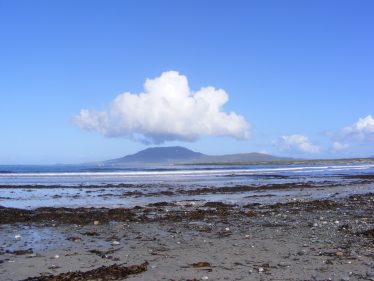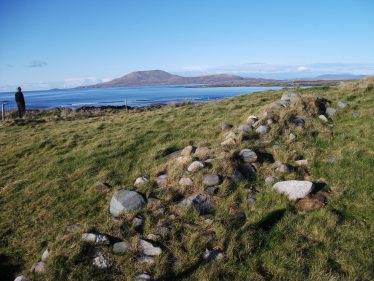I often take a walk on the beautiful peaceful beach in Doughmakeon listening to the rolling waves caressing the shore and the seabirds happily going about their business.
It is hard to imagine that many years ago, this beach was a hive of activity from November to March. The action started when the “Purt of Wrack” or “Purt Feamainne” came ashore. The sea rods had landed.
In 1942, the Gaeltacht Services Division succeeded in finding a buyer in Scotland who was prepared to take large quantities of sea rods in an air-dried state as were harvested in the West of Ireland. In 1947, a private company was formed for the purpose of establishing a factory in Kilkerrin, Co Galway to grind the sea rods into meal and export the material in meal form. It was time to start harvesting the sea rods.

Sea rods on Doughmakeon beach
The first job was to pay a visit to the landowner of the Dumhach to rent a small piece of land to erect the stone walls for drying the sea rods. When this was agreed, the stones were carried up from the shore and the building began. The wall was built to a height of approximately twenty inches and a width of twelve inches. Some families would build two or three walls.
Sea rods grow in about eighteen feet of water. They are torn from their moorings by storms and cast up on to the shore by the waves. The men did the cutting as the sea rods are attached to a head of wrack. This was broken off (The wrack was later used to fertilize the land). They threw the rods, which could be up to four feet in length, inshore above the water line. At times the men could be up to knee deep in water.
The young boys would be waiting on the shore with the horses and carts to collect the rods and load them into the carts, others had donkeys with V shaped wooden cliabhs for the loading. These had an opening front and back to slot the rods through.
When they were loaded, they took them up to the stone walls and laid them sparingly across the top of the wall. For every ton of dried sea rods, approximately eight cart loads would be brought out, a vast amount of moisture was lost in the drying process.
This work would continue for many hours depending on the tide. One man remembers coming home from a dance at two o’ clock in the morning and being awoken by his father one hour later to set off for the shore. He worked right through until seven o’clock that evening.
The sea rods could come ashore every day for a fortnight at a time depending on sea conditions. There would be up to thirty people from the village engaged in the harvesting at any one time, with another twenty to thirty people coming from outlying areas with horses and carts to collect the wrack to fertilize the land.
Depending on weather conditions, the sea rods would dry or “season” in three to four weeks and once they were ”seasoned” the rain could no longer rot or affect them.
Sea rods had become a very useful raw material in the production of many commodities including iodine, cattle feed, cosmetics, medicine and a range of other products.
An agent for the area would supply the ropes to tie the sea rods in bundles and would come back later to weigh them. In 1947 the price paid per ton was £4.10. This increased to £5.10 in 1957. The average harvest for most families was about ten tons, although harvests of fifteen to twenty tons were not unheard of. They would be collected in late spring or early summer by lorry and the cheque would come later by post. This was indeed a very welcome supplement to the family income.
The women and girls would come down at break time with bottles of tea, soda bread, boiled eggs and occasionally cold boiled bacon or mutton which was thoroughly enjoyed by the workers as the seaside was a great place for getting an appetite. Although the work was often backbreaking and cold, a great camaraderie existed between the workers. It was a time for craic and laughter and many stories were told.

Stone wall on Doughmakeon Dumhach
The harvesting drew to a close in the 1980’s. The Japanese were developing new methods of farming and mechanically harvesting the sea rods and this small patch of the western seashore was once again returned to the seabirds and walkers.
Should archaeologists ever do a dig in the Dumhach in years to come, they will wonder what purpose these stone walls served.






Comments about this page
Very interesting story and information.
Great story Brenda, I was only down at Doughmakeon last week collecting some seaweed for my new veggie patch. Little did I know it had been done there for centuries. I normally only collect the Flat Wrack and discard the Rod as it doesn’t break down very well. With the revival of people ‘growing their own’ we may see a return to this lost tradition!
Add a comment about this page